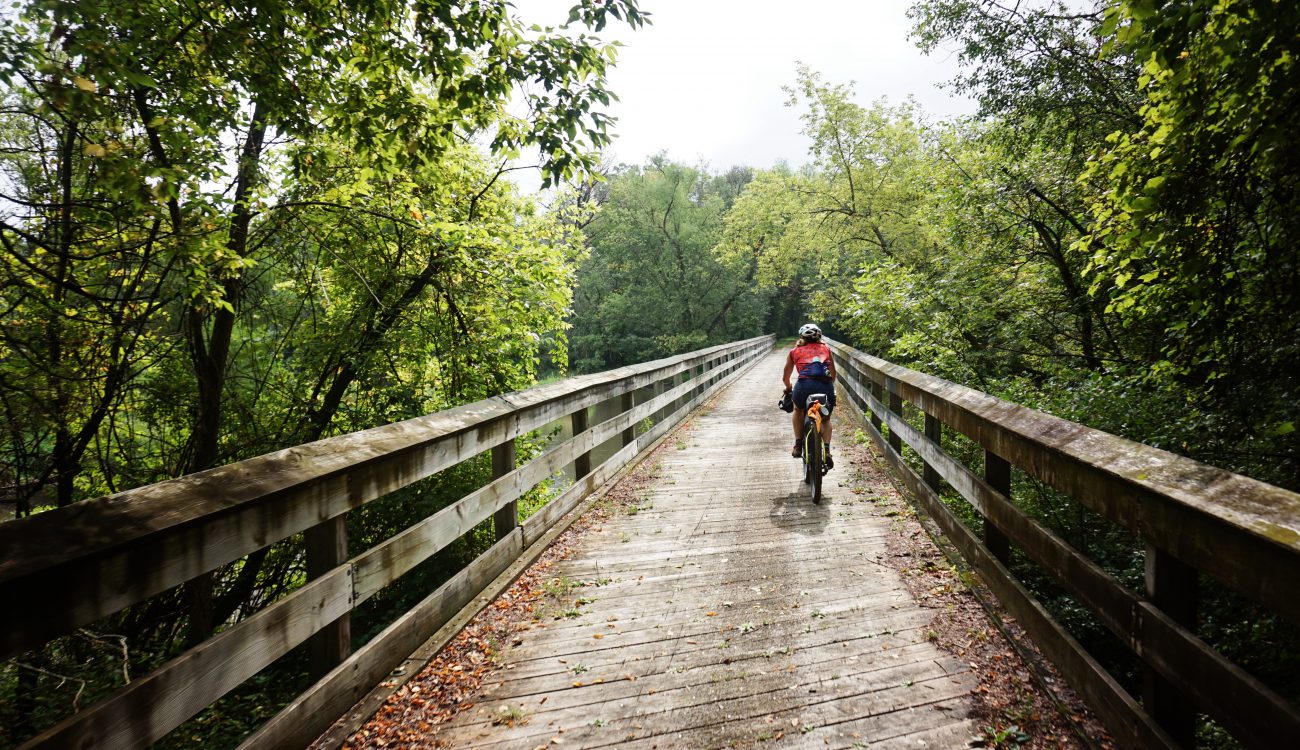
99 Bridges
Bikepacking Wisconsin's Dairyland
The following is an account of the four-day trip I took with my wife and our good friend Art Brown II.
When I married my wife, Laura, 14 years ago, I also married a little bit of Wisconsin, too, as she was born and raised in Oshkosh. I have been an avid cyclist my entire life and Laura has really gotten into cycling over the last handful of years. She is now quite the accomplished cyclist, having done a strenuous bikepacking trip in Montana and completed numerous 100 and 200 mile gravel races all over the country. I, too, have done a little bikepacking, but we had never done one of any distance together. This past summer we decided to change that.
After riding the first day we noticed we had gone over a significant number of small bridges. The trails we rode were former railways, where bridges allowed trains to pass over streams and farm crossings. When we set out on our second day of the trip we started yelling out the number of every new bridge we crossed. In the final mile of our 225-mile excursion, we encountered bridge number 99.
LOCATING THE GRAVEL
Putting together the route involved finding all the gravel roads I could between campsites. With information gleaned from fellow cyclists, Gravel Maps and Google Maps, I pulled together a four-day route that was 65% gravel.
Settling on Verona as a starting point, I quickly contacted Atkins Verona Bicycle Shoppe to inquire about leaving our vehicles for the duration of the trip. Dan Atkins, the owner, was quick to welcome us to park our cars in his lot.
Dan and his family have been in the bike business since 1955 when Dan’s father and grandfather first opened a shop on the west side of Madison. Dan and his brothers grew up working in their father’s store, and when his dad sold the business in 1982 to a competitor it didn’t take long before Dan realized he wanted to own a bike shop. He opened his own store in Verona in 1983. I highly recommend anyone planning to tackle this route to stop in and say “hi” to Dan and the staff. They truly are good people.
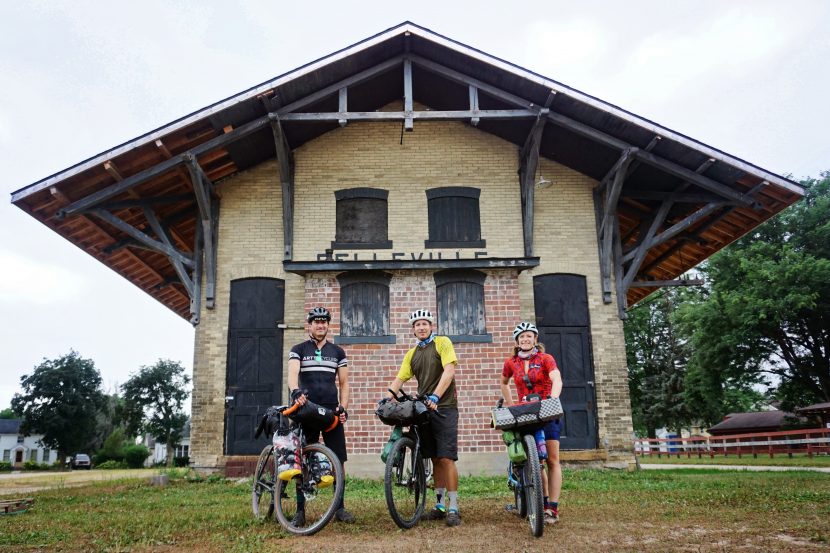
THE JOURNEY BEGINS
With our friend, Art, driving down from Minneapolis and Laura and I coming from Oshkosh, we chose to have a short first day on the bikes. We set out on a Sunday hoping we would have the trails to ourselves and better camping options each night.
With our bikes packed and the route loaded into my Garmin, we pedaled out of Verona destined for New Glarus State Park. The highlight of the route was to be the Stewart Tunnel on the Badger State Trail.
Construction of the 1,200-foot-long Stewart Tunnel began in 1886 to connect Freeport, Illinois, to Madison via railway. Built with hand-fired bricks and natural limestone, the tunnel has a slight curve in the middle, resulting in near complete darkness within.
Imagine my disappointment when, within a mile of the tunnel, we found fencing and notices from the Wisconsin Department of Natural Resources informing us the tunnel was closed due to safety concerns. Not interested in breaking the law to see the tunnel, we followed the reroute. At the same time, a large storm rolled in. If only we had had a tunnel in which to wait it out. Instead the rain clouds opened up, drenching us.
WAITING OUT THE STORM
The hard rain reduced visibility to near zero, but we made it to New Glarus State Park and took refuge under a picnic shelter. We waited for the storm to abate by wringing out our wet clothes. Then we ventured into the town of New Glarus in search of dinner.
In the early 1840s, after several years of failed crops, much of the canton of Glarus in Switzerland found itself deep in poverty. With more workers than available jobs, the Glarus Emigration Society was established in 1844 and offered loans to help residents purchase land in America. Nearly 200 volunteers decided to leave their homelands to start anew, founding the town of New Glarus.
Fast forward to 1993 when Deborah and Dan Carey founded New Glarus Brewing Co. The brewery grew quickly, and in 2004 they broke ground on a $20-million facility to handle the increasing demand for their beer. Despite selling their beer exclusively in Wisconsin, the New Glarus Brewing Co. is the 25th largest brewery in the United States.
The original plan was to pair my love for bikes and my love for beer with a trip to the brewery. But due to the ongoing COVID-19 pandemic, the brewery was closed for the summer. Instead we were able to get a great meal out on the patio of Sugar River Pizza Co. Established in 2013, Sugar River is a family-run business with a made-from-scratch menu serving up pizza, calzones, salads and a vast selection of local and regional beers.
After we filled our bellies, we sought out the local liquor store for a small bottle of bourbon. We then stopped at the laundromat across the street to dry our wet clothes and shoes. We spared ourselves no such creature comforts on this bikepacking trip.
There are two campgrounds at New Glarus State Park. One is directly off the bike path coming back from town. These sites are only accessible by bicycle or foot but are also the closest to the highway, and suffer from lots of truck traffic noise. The other section is farther away from the highway but also accessible by vehicle, so we expected to see more camper trailers. Though the park offices were closed, firewood was available for purchase on the honor system.
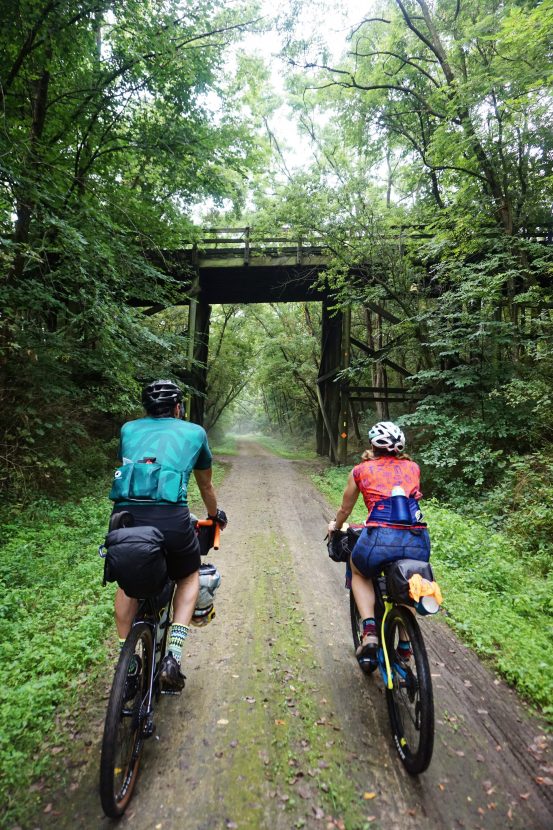
THE ICE AGE
The Sugar River State Trail, from Exeter Crossing Road outside New Glarus to Bump Road near Albany, is on the route of the Ice Age National Scenic Trail. More than 12,000 years ago, a mammoth flow of glacial ice carved out the landscape across southern Wisconsin. As the glacier retreated, it left behind a variety of unique features. These glacial remnants are now widely considered some the world’s finest examples of how continental glaciation sculpted the earth.
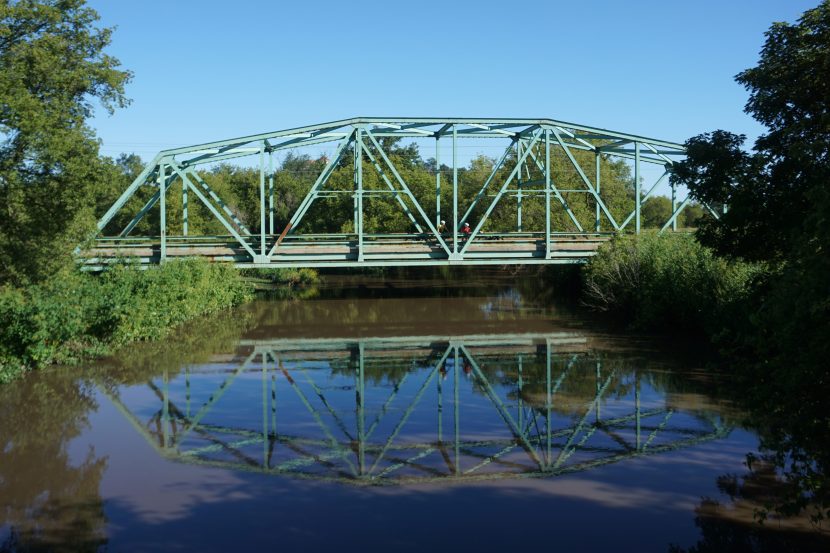
BRIDGES AND BARN QUILTS
Leaving New Glarus, the Sugar River State Trail follows an abandoned railroad line for 24 miles all the way to Brodhead. It has 14 bridges spanning the river as the trail passes through woods and farmlands, over rolling hills and through prairies.
The Clarence Covered Bridge, just north of Brodhead, crosses Norwegian Creek. This replica 1800s covered bridge was built in 1984. Covered bridges were built to shelter wooden bridges from inclement weather and to allow farmers with cattle to cross safely. Covered bridges were once commonplace in Wisconsin, with nearly 40 of them at one point. The advent of concrete and steel bridges made covered bridges obsolete but a handful of replicas remain.
Heading west, we ventured back onto pavement. Riding past fields of cows grazing on lush green fields, picturesque dairy farms dotted the horizon. We also began to notice intricate colorful quilt patterns painted on the sides of barns.
The barn quilts are unique family designs that have been passed down through the generations. The family’s quilt pattern is painted onto wood and then hung, creating a quilt trail one can follow.
ALWAYS STOP FOR ICE CREAM
By the time we reached the town of Monroe, the temps were already in the 90s with humidity in the high 80s. It felt like riding in a hot bath. So when we saw the sign for ice cream, it was like a beacon of light calling us in.
Local resident and businessman Jim Becker decided the community could use a quality hardware store, so he opened a Hardware Hank so no one would need to drive out of town to get tools and supplies. But then he added something extra: Jim had always wanted to open an ice cream parlor, too, so he opened the Swirl Station next door. Now families can enjoy the best ice cream around, as well as burgers, pulled pork, chicken and hot dogs. Only a small detour from the Badger State Trail, I recommend checking it out. Refuel with a cheeseburger and a scoop of chocolate caramel brownie explosion in a waffle cone while soaking in the air conditioning before moving on.
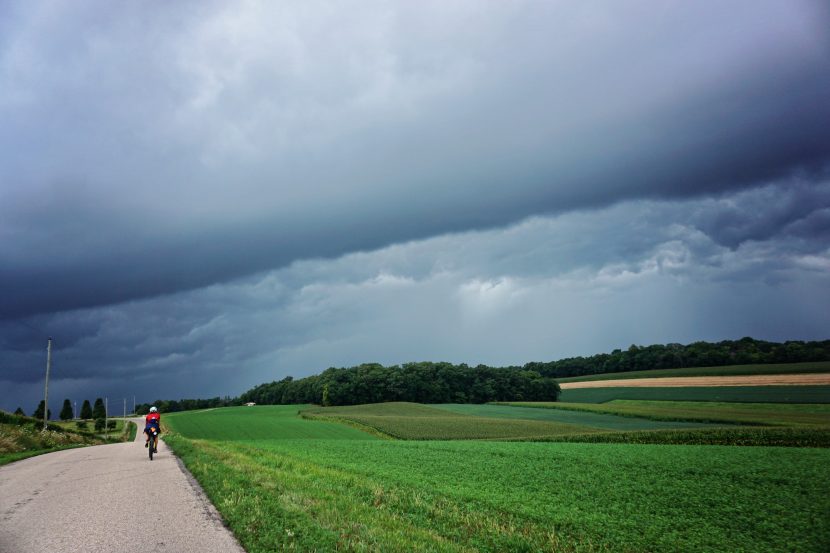
STORMS BREWING
Leaving Monroe, we ventured onto the Cheese Country Trail and could see the storm clouds rolling our way. Checking radar on our phones, we figured we had an hour before meeting the storm front. So we set off to see if we could make it to South Wayne.
The rain started to fall sooner than expected, and as we rode we looked for places to take shelter. With the rain increasing and the wind picking up, we made it to Browntown in the nick of time. We sheltered on the front porch of a local tavern that was closed at the time. In short order, the storm went from heavy rain to torrential downpour with a straight-line wind. Things went from bad to worse when the tornado sirens sounded and multiple firetrucks went screaming by. We hunkered down below the concrete porch slab in a small cellar door opening. The wind was so strong we saw large dairy trucks pull over to avoid being blown off the road. All we could do was don our dry layers, huddle together to stay warm and wait it out.
Once the storm abated, we repacked our gear before heading out again. We found the trail littered with full size trees blown down by the wind. After bushwhacking for five miles, we realized we would not make it to our destination at our current pace. We pieced together a road route that eliminated 10 of the 17 miles of the gravel trail we had planned to follow.
THE DARLING TOWN OF DARLINGTON
Darlington is known as the “Pearl of the Pecatonica” for the time when people harvested clams out of the river to produce pearl button blankets. This small charming community is the county seat of Lafayette County.
Pecatonica River Trails Park is a city-run campground with 24 sites of riverfront camping. A hot shower for 50 cents was a welcome bargain after our time in the rain. Also in order was a stop at the Piggly Wiggly for a six pack of New Glarus Moon Man and another stop at the laundromat to use a dryer. Setting up our tents in one of the nonelectric sites, we were afforded the sound of the passing river as we ate beside a warm fire to finish the day.
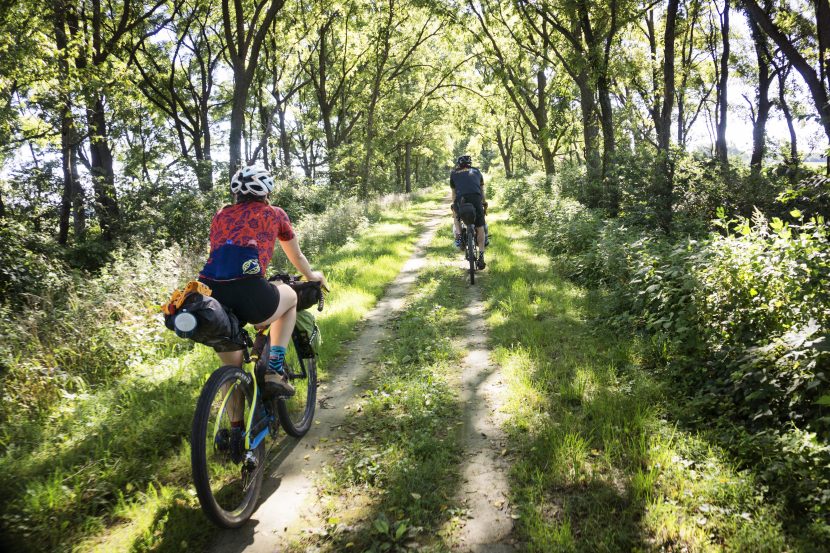
THE BIG PUSH
Having planned the route, I knew the real test of our strength would come on the third day when we’d need to tackle half of the route’s entire elevation gain over 70 miles.
That morning started out beautifully as we rose early to make use of the cooler weather. We started back on the Cheese County Trail, a trail that I understand can be heavily trafficked by ATVs on the weekends. Being a weekday, though, we saw only a few of the wider two-seater UTVs. What we did encounter was lots of freshly laid chunky gravel which made for slow going.
Arriving in Mineral Point, we exited the trail and got back on pavement. The next section of the route, leaving Mineral Point to Linden, was by far the most dangerous. The route had us on a well-trafficked road with no shoulder and a handful of sweeping turns. My Garmin Varia radar alerted us to approaching vehicles so we could get onto the rocky shoulder to avoid being struck by a distracted driver. If I were to do this ride again I would avoid this stretch and add a few extra miles on other area roads.
GOVERNOR DODGE STATE PARK
Our destination for our final night of the trip was Governor Dodge State Park. The park is named after the first territorial governor of who served from 1836 to 1841. The park is large with two campgrounds, including a backpacking-only campground. The backpacking sites are located at the northern-most part of the park and were our initial destination until we stopped at the small Jumping Jupiter General Store just outside the park entrance.
Cold beer and firewood were a strong draw. Store owners Susan and Doyle are some of the kindest people you will ever meet. They volunteered to drive our purchases to our campsite.
STEPHENS FALLS
Stephens Falls, located within the state park, is a waterfall that flows over a mossy cliff into a small pool 20 feet below. The falls are named for the Stephens family, who operated a farmstead there from 1854 until 1943.
Biking is not allowed on the path to the falls so we left our bikes just a short way down the trail out of view from passing cars. The trail to the falls is short, less than half a mile. Along the way we found the remains of the Rock Spring House. Built in the 1850s on top of a natural spring, it was used by the Stephens family to keep their food and milk cold. Rusted pipes inside are evidence of the pump that once drew water from the spring to storage tanks uphill.
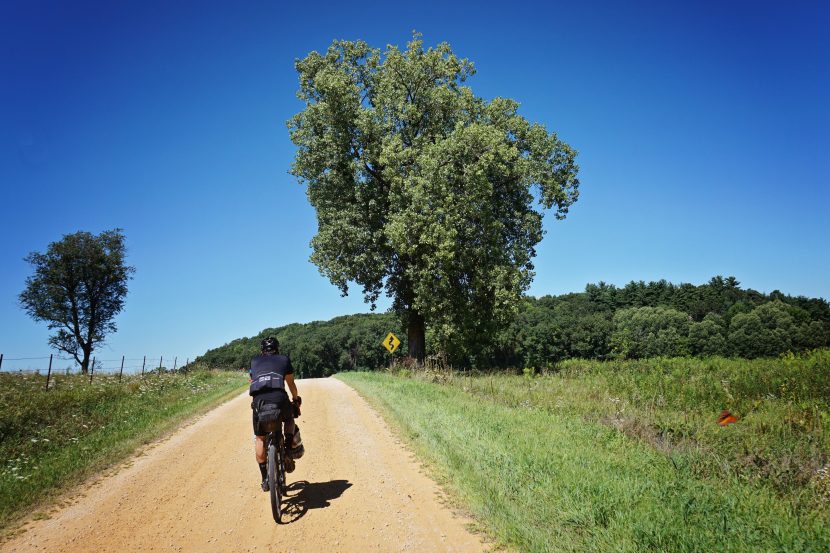
THE HOMESTRETCH
Leaving Fort Dodge, we hooked up with the Military Ridge Trail that would take us all the way back to Verona. The history of the Military Ridge corridor dates back to the mid-1800s. In 1835, the Army built a road connecting Green Bay with Fort Crawford in Prairie du Chien. The section between Dodgeville and Mount Horeb runs along the top of the ridge, the divide between the Wisconsin River watershed to the north and the Pecatonica and Rock River watershed to the south. The mostly crushed limestone trail follows the former Chicago and Northwestern railway corridor and can be covered quickly by bike.
Worth a detour is Blue Mound State Park. Located atop the largest hill in the southern half of the state, a steep climb brings you to the base of two observation towers affording views of the Wisconsin River Valley. Unfortunately, the towers were closed when we visited. The view from below is stunning nevertheless.
Our final stop of the trip was for one final cheeseburger at the Grumpy Troll Brew Pub in Mount Horeb. A couple pints were just what was needed for the final stretch of trail. I tried the radler, a shandy-style brew that combines lemonade with beer. It originated in early 20th-century Germany, where — as the legend goes — a group of parched cyclists swarmed a bar on a popular cycling route. The bartender was almost out of beer, and in a moment of panic, he mixed what beer he had with lemon water. The drink was well-received by the riders, and grew to become incredibly popular in beer gardens in Munich and beyond. A nod to the pedalers that inspired the beverage, the concoction was called a radle, which means “cyclist” in German.
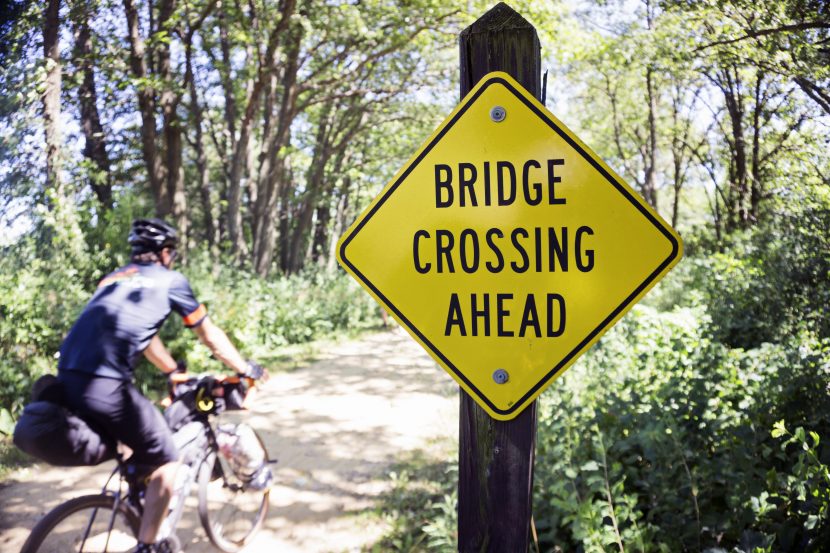
BACK TO REALITY
Arriving once again in Verona, hot and sweaty, we packed up our bikes and gear in our cars, said our goodbyes and headed home. On the drive back to Oshkosh to be reunited with our children, I couldn’t help but begin to ponder the next adventure.
Scott Haraldson works for Quality Bicycle Products in Bloomington, Minn. He lives in nearby Maplewood with his wife, their four children and two dogs.